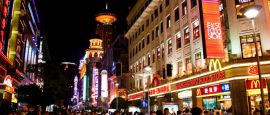Shanghai History
Originally little more than marshland, Shanghai was an insignificant village for much of its early history, and was inhabited by people from the Majiabang tribe from around 5000BC. Thanks to its proximity to the coast, it became a port during the years of the Eastern Jin and Tang dynasties, before being officially upgraded from village status to market town in 1074 by the Southern Song dynasty.
The Yuang rulers turned it into a city in 1291, with Shanghai becoming an important port and home to an Imperial garrison. Under the mediaeval Ming rulers, the city continued to develop, with the Huang River being dredged to allow more shipping and a city wall erected in 1553 to see off pirates. But for all the development, it wasn't until after the British opened their concession here in 1842 that modern Shanghai really came into being.
The British presence in Shanghai was soon followed by the French and Americans, and by 1853 Shanghai had overtaken all other Chinese ports. Built on the trade of opium, silk and tea, the city also lured the world’s great houses of finance, which erected grand palaces of plenty. Shanghai also became a byword for exploitation and vice; its countless opium dens, gambling joints and brothels managed by gangs were at the heart of Shanghai life.
The Kuomintang government cooperated with the foreign police and the Shanghai gangs, as well as Chinese and foreign factory owners, to suppress labour unrest. As a result, the poor of Shanghai developed an appetite for radical politics and the Chinese Communist Party (CCP) was formed in the city in 1921. In 1949, after numerous setbacks, they went on to ‘liberate’ Shanghai.
The communists eradicated the slums, rehabilitated the city’s hundreds of thousands of opium addicts, and eliminated child and slave labour, but when the decadence went, so did the splendour, and Shanghai soon became a colourless factory town. Shanghai’s long malaise came to an abrupt end in 1990, with the announcement of plans to develop Pudong, on the eastern side of the Huangpu River. The city's now famous neon-lit skyline soon followed.
Did you know?
• The hu character on Shanghai license plates come from the city’s original name – Hudu – which in turn came from the word used to describe wooden fish traps.
• From 1863 to 1865, Yu Garden was home to the Small Swords Society – a Triad group.
• The world’s tallest statue of Frederic Chopin is in Zhongshan Park.
Do you have any Feedback about this page?
© 2026 Columbus Travel Media Ltd. All rights reserved. No part of this site may be reproduced without our written permission, click here for information on Columbus Content Solutions.




 You know where
You know where